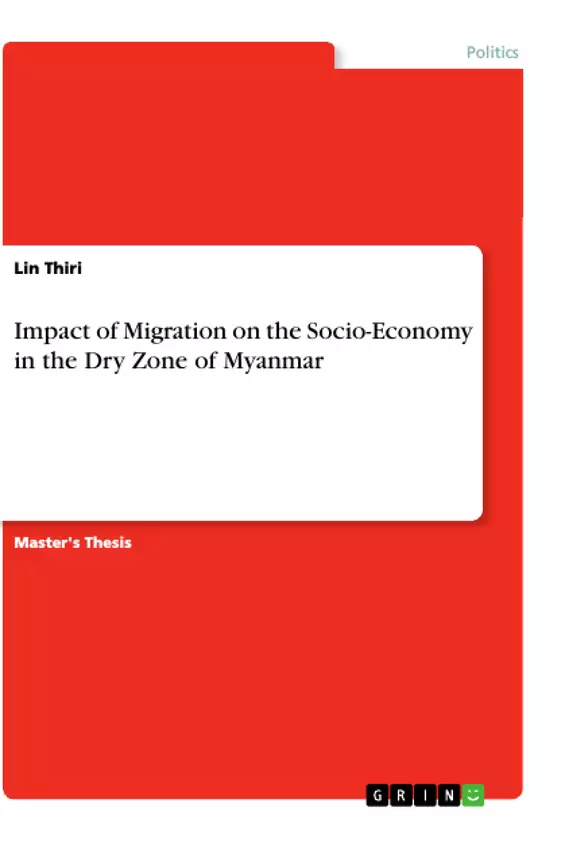This paper investigated the impact of migration on socio-economy in the rural area of Myanmar. Moreover, secondary data collected from concerned Ministries, United Nations agencies and related scholars and websites. Data collection conducted about 12.02 % of total households from six sample villages through household survey and field observations. Findings from the study showed that about one fourth of household members were migrants who were mostly young and active men. The youngest age at initial migration was 15 years. Their education levels were mostly secondary and migrated in the years of 2005. Common migration was international (cross-border migration) following by internal (rural to urban out-migration). Remittance of migrant was significantly high and it was about half of total households’ income.
Migration is recognizing as a universally popular trend around the world. The roots of migration are the economic, social, political, cultural, environmental, health, education and transportation. Moreover, it is important in the socio-economic development and population growth of a country, mainly for the providing of occupation and social amenities to the migrants and their relatives. Agriculture is the main livelihoods in rural areas of Myanmar; farm labors are major source of employment opportunity for farming however their socio-economic status is still lower.
Moreover, the socioeconomic status of farmers has been more adversely affected by the unpredictable climate changes, natural, disasters and others, year after year. For that reason, Myanmar rural nationals are practicing migration as their income diversification strategies to solve their economic and social status as like other developed and developing countries. As a result, this research aims at to examine the socio-economic characteristics of migrants and to extract the significant features of pull and push factors of migration in rural area of Myanmar.
Inhaltsverzeichnis (Table of Contents)
- Chapter-1 Introduction
- 1.1 Background of Research
- 1.2 Literature Review
- 1.3 Research questions
- 1.4 Research objectives
- 1.5 Research Methods and Materials
- 1.6 Outline of Thesis
- Chapter-II Conceptual Framework of Migration
- 2.1 What is migration? : Characteristic of migration
- 2.2 General theories of Myanmar migration compare with other countries
- 2.3 Impact study of migration on different economic and social indicator
- 2.3.1 Impact study of migration on Income
- 2.3.2 Impact study of migration on Expenditures
- 2.3.3 Impact study of migration on Education
- 2.3.4 Impact study of migration on Health
- 2.3.5 Impact study of migration on labor problem and crop production
- 2.4 Methodology of migration
- 2.5 Pull and push factors of migration
- Chapter- III Migration and socio-economic situation in Myanmar
- 3.1 Economic performance of Myanmar concerning with FDI and ODA
- 3.2 Migration in Myanmar
- 3.2.1 General view of migration pattern in Myanmar
- 3.2.2 Major migration flows and their roles in rural Myanmar
- 3.2.3 Myanmar migration policies
- Chapter IV Impact of migration on socio-economy in the dry zone of Myanmar: A case study.
- 4.1 Background information
- 4.2 Data source and collection methods
- 4.3 Review of household members and migrants
- 4.4 Impact of migrants on the livelihood of households
Zielsetzung und Themenschwerpunkte (Objectives and Key Themes)
This research aims to examine the socio-economic characteristics of migrants in rural areas of Myanmar and to analyze the significant features of pull and push factors driving migration. The study focuses on the impact of migration on the socio-economic situation in rural areas of Myanmar, using a case study in Kyaukpadaung township, a dry zone area.
- The impact of migration on income and expenditures of households.
- The influence of migration on education and health outcomes in rural areas.
- The role of migration in addressing labor problems and crop production challenges.
- The identification and analysis of pull and push factors influencing migration decisions.
- The investigation of the socio-economic impact of migrants on rural households.
Zusammenfassung der Kapitel (Chapter Summaries)
Chapter 1 provides a comprehensive introduction to the research, outlining the background, literature review, research questions, objectives, methodologies, and a thesis outline. Chapter 2 delves into the conceptual framework of migration, defining migration and exploring its characteristics, general theories of Myanmar migration in comparison to other countries, and analyzing the impact of migration on various economic and social indicators. Chapter 3 examines the socio-economic situation in Myanmar, specifically focusing on the country's economic performance in relation to foreign direct investment and official development assistance. It further explores migration patterns in Myanmar, including major migration flows and their roles in rural communities, and a review of Myanmar migration policies. Chapter 4 presents a case study on the impact of migration on the socio-economy in the dry zone of Myanmar, specifically in Kyaukpadaung township. This chapter examines background information, data sources and collection methods, reviews household members and migrants, and analyzes the impact of migrants on household livelihoods.
Schlüsselwörter (Keywords)
The research focuses on migration, socio-economic impact, rural areas, Myanmar, pull and push factors, income diversification, household livelihoods, case study, Kyaukpadaung township, dry zone, data collection, household surveys, field observations, and remittance.
- Citation du texte
- Lin Thiri (Auteur), 2018, Impact of Migration on the Socio-Economy in the Dry Zone of Myanmar, Munich, GRIN Verlag, https://www.grin.com/document/535063



